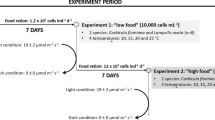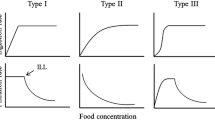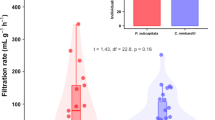Summary
Filtration rate capacities in undisturbed freshwater bivalves were determined by means of two different methods (indirect “clearance” and “suction” methods) in Anodonta anatina (L.), Unio tumidus Philipsson, Unio pictorum (L.), Unio crassus Philipsson, Dreissena polymorpha (Pallas) and Sphaerium corneum (L.). In A. anatina, D. polymorpha, and S. corneum the filtration rate (FR, 1 h-1) at 19–20°C as a function of dry tissue weight (DW, g) or ash-free dry weight (AFDW, g) could be expressed by the equations: 1.10 DW0.78, 6.82 DW0.88, and 2.14 AFDW0.92, respectively. In U. tumidus, U. pictorum, and U. crassus filtration rates were comparable with those of A. anatina. In D. polymorpha the b value of the corresponding regression of gill area on dry weight was 0.87. The rates of water transport in freshwater bivalves are 2–8 times lower than in marine bivalves of comparable size. A corresponding difference in the filtration rate per gill area unit is found. The measured filtration rates in undisturbed bivalves are substantially higher (at least 4 times) than previously reported. This indicates that the impact of bivalve water processing on freshwater ecosystems is greater than hitherto suggested.
Similar content being viewed by others
References
Alimov AE (1965) The filtrational ability of mollusks belonging to the genus Sphaerium (Scopuli). Dokl Biol Sci [Engl Transl] 164: 195–197
Alimov AF (1969) Nekotorye obscie zakonomernosti processa filtracii u dvustvorcatych molljuskov. Zh Obschch Biol 30: 621–631
Benedens H-G, Hinz W (1980) Zur Tagesperiodizität der Filtrationsleistung von Dreissena polymorpha and Sphaerium corneum (Bivalvia). Hydrobiologia 69: 45–48
Coughlan J (1969) The estimation of filtering rate from the clearance of suspensions. Mar Biol 2: 356–358
DeBruin JPC, Davids C (1970) Observations on the rate of water pumping of the freshwater mussel Anodonta cygnea zellensis (Gmelin). Neth J Zool 20: 380–391
Famme P, Riisgård HU, Jørgensen CB (1986) On direct measurements of pumping rates in the mussel Mytilus edulis. Mar Biol 92: 323–327
Hinz W, Scheil H-G (1972) Zur Filtrationsleistung von Dreissena, Sphaerium und Pisidium. Oecologia (Berlin) 11: 45–54
Izvekova EI, Lvova-Katchanova AA (1972) Sedimentation of suspended matter by Dreissena polymorpha Pallas and its subsequent utilization by Chironomidae larvae. Pol Arch Hydrobiol 19: 203–210
Jørgensen CB, Kiørboe T, Møhlenberg F, Riisgård HU (1984) Ciliary and mucus-net filter feeding, with special reference to fluid mechanical characteristics. Mar Ecol Prog Ser 15: 283–292
Jørgensen CB, Famme P, Saustrup Kristensen H, Larsen PS, Møhlenberg F, Riisgård HU (1986) The bivalve pump. Mar Ecol Prog Ser 34: 69–77
Klee O (1971) Die großte Kläranlage im Bodensee: Eine Muschel. Mikrokosmos 5: 129–131
Kondratév GP (1962) [Cited by Alimov (1969)]
Kondratév GP (1963) O nekotoryh osobennostjah filtracii u presnovodnyh molljuskov. Naucnye doklady vyssej skoly. Biol Nauki (Moscow) 1: 13–16
Lewandowski K, Stańczykowska A (1975) The occurrence and role of bivalves of the family Unionidae in Mikolajskie Lake. Ekol Pol 23: 317–334
Micheev VP (1966) O skorosti fil tracii vody Drejssenoj. Tr Inst Biol Vodokhran Akad Nauk SSSR 12: 134–138
Møhlenberg F, Riisgård HU (1978) Efficiency of particle retention in 13 species of suspension feeding bivalves. Ophelia 17: 239–246
Møhlenberg F, Riisgård HU (1979) Filtration rate, using a new indirect technique, in thirteen species of suspension feeding bivalves. Mar Biol 54: 143–147
Morton B (1971) Studies on the biology of Dreissena polymorpha Pall. v. Some aspects of filter-feeding and the effect of microorganisms upon the rate of filtration. Proc Malacol Soc London 39: 289–301
Stańczykowska A (1977) Ecology of Dreissena polymorpha (Pall.) (Bivalvia) in lakes. Pol Arch Hydrobiol 24: 461–530
Stańczykowska A (1984) Role of bivalves in the phosphorus and nitrogen budget in lakes. Verh Int Ver Theor Angew Limnol 22: 982–985
Stańczykowska A, Lawacz W, Mattice J (1975) Use of field measurements of consumption and assimilation in evaluation of the role of Dreissena polymorpha Pall. in a lake ecosystem. Pol Arch Hydrobiol 22: 598–520
Stańczykowska A, Lawacz W, Mattice J, Lewandowski K (1976) Bivalves as a factor effecting circulation of matter in Lake Mikolajskie (Poland). Limnologica 10: 347–352
Walz N (1978) The energy balance of the freshwater mussel Dreissena polymorpha Pallas in laboratory experiments and in Lake Constance. I. Pattern of activity, feeding and assimilation efficiency. Arch Hydrobiol [Suppl] 55: 83–105
Williams LG (1982) Mathematical analysis of the effects of particle retention efficiency on determination of filtration rate. Mar Biol 66: 171–177
Winter JE (1977) A critical review on some aspects of filter-feeding in lamellibranchiate bivalves. Haliotis 7: 71–87
Author information
Authors and Affiliations
Rights and permissions
About this article
Cite this article
Kryger, J., Riisgård, H.U. Filtration rate capacities in 6 species of European freshwater bivalves. Oecologia 77, 34–38 (1988). https://doi.org/10.1007/BF00380921
Received:
Issue Date:
DOI: https://doi.org/10.1007/BF00380921




